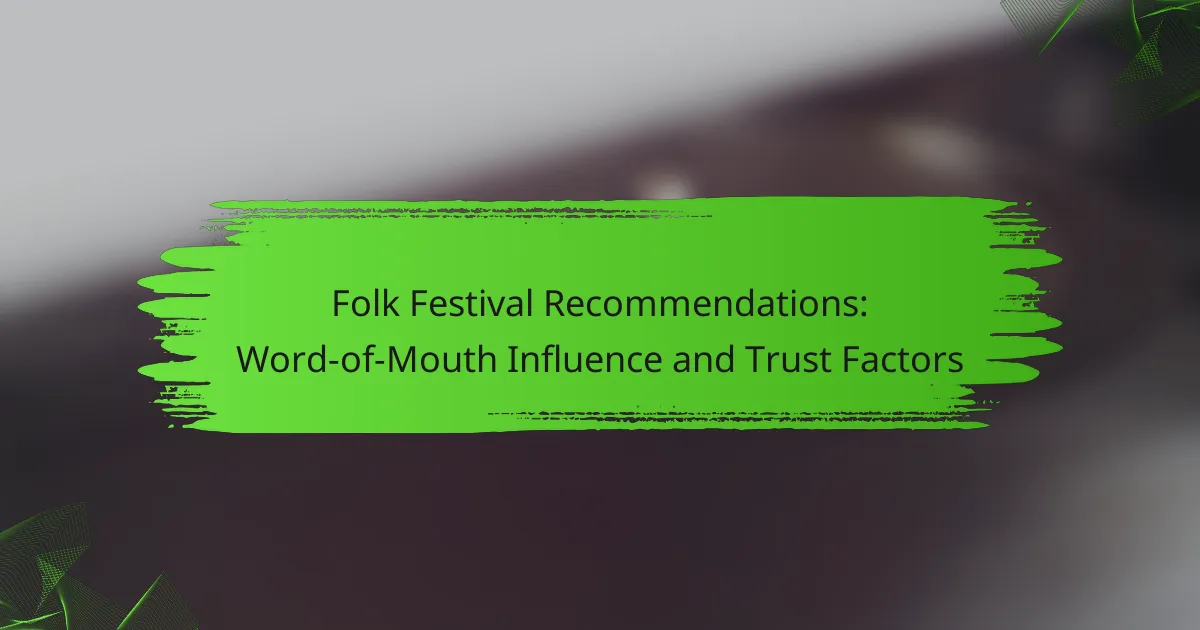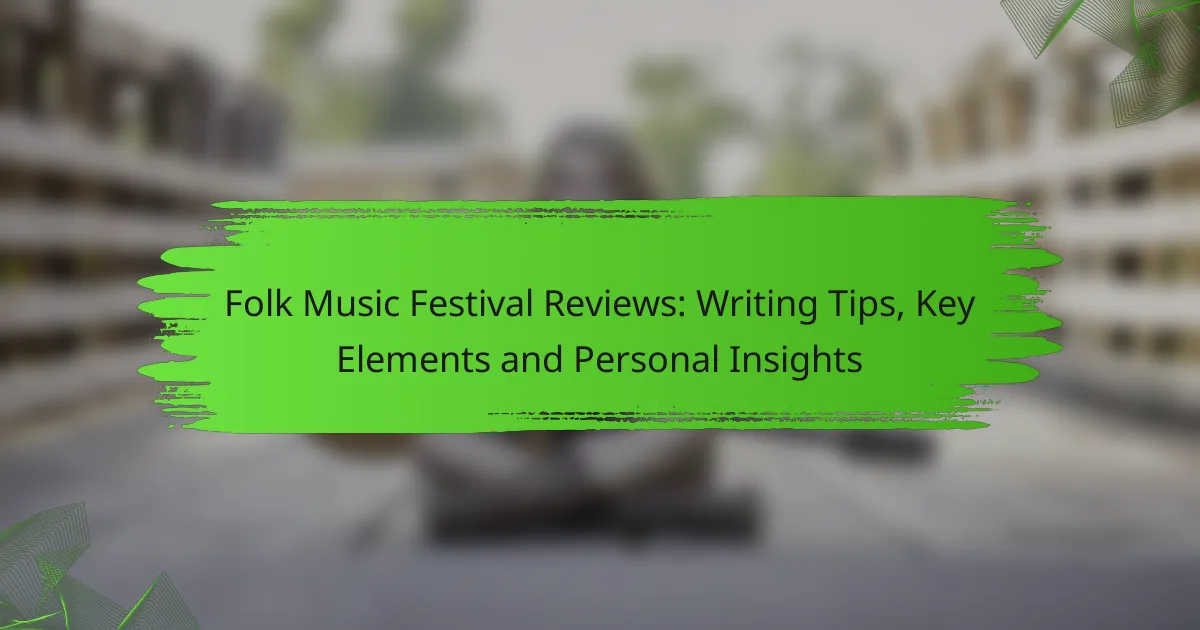Folk festivals across the US are celebrated for their lively music and strong community ties, often recommended through word-of-mouth. Personal endorsements from friends and family enhance credibility and influence attendance, as potential festival-goers seek authentic experiences. Key trust factors, such as artist reputation and attendee reviews, play a crucial role in shaping decisions about which festivals to explore.
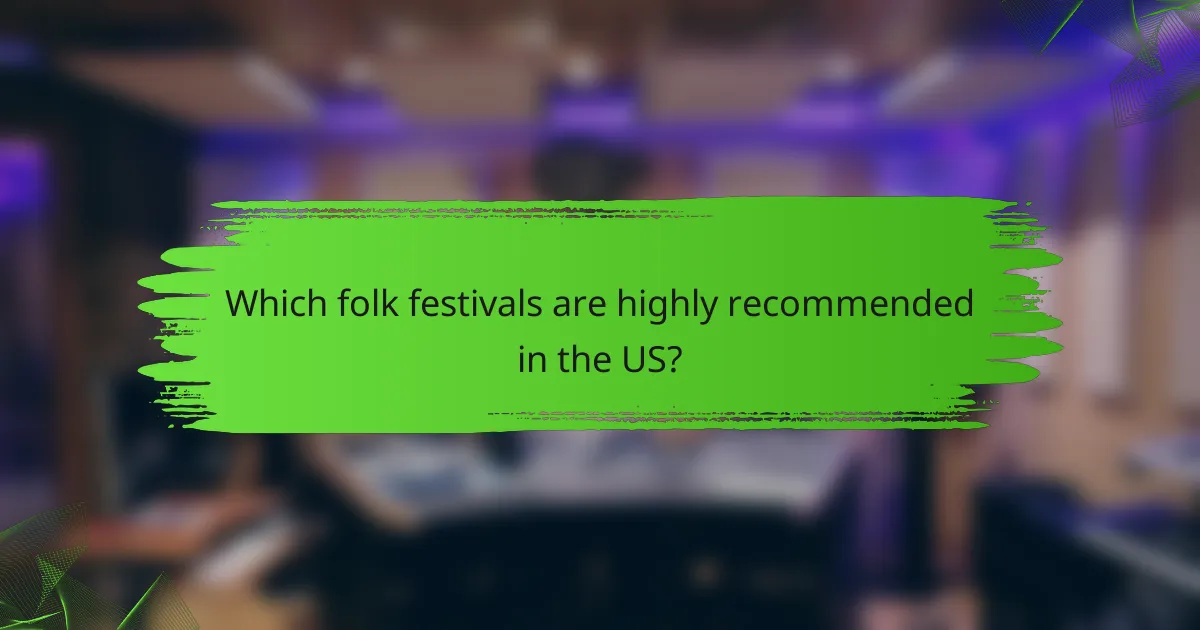
Which folk festivals are highly recommended in the US?
Several folk festivals in the US are renowned for their vibrant music, community spirit, and cultural significance. Recommendations often stem from word-of-mouth, highlighting festivals that offer unique experiences and diverse lineups.
Newport Folk Festival
The Newport Folk Festival, held annually in Rhode Island, is celebrated for its historic roots and eclectic lineup. Founded in 1959, it has hosted legendary artists and continues to attract top talent across various folk genres.
Attendees can expect a mix of established acts and emerging artists, often performing in a picturesque seaside setting. It’s advisable to purchase tickets early, as this festival frequently sells out.
MerleFest
MerleFest, located in Wilkesboro, North Carolina, is a tribute to the late Merle Watson and features a blend of bluegrass, folk, and Americana music. This festival typically occurs in late April and draws large crowds, making it a staple in the folk music community.
With multiple stages and a family-friendly atmosphere, MerleFest offers workshops and activities for all ages. Planning ahead for accommodations is recommended, as nearby lodging fills quickly.
Philadelphia Folk Festival
The Philadelphia Folk Festival, one of the longest-running festivals in the US, showcases a wide array of folk music styles. Held each August, it features performances from both local and international artists, creating a rich cultural tapestry.
This festival also emphasizes community engagement, with opportunities for attendees to participate in workshops and jam sessions. Consider bringing camping gear if you want to fully immerse yourself in the festival experience.
Woodstock Folk Festival
The Woodstock Folk Festival in New York celebrates the spirit of the original 1969 festival while focusing on contemporary folk music. This event typically takes place in the summer and features a variety of performances in a scenic outdoor setting.
Attendees can enjoy not only music but also art and craft vendors, enhancing the festival atmosphere. It’s wise to check the festival’s website for updates on artists and ticketing options.
American Folk Festival
The American Folk Festival, held in Bangor, Maine, brings together diverse musical traditions from across the country and around the world. This festival usually occurs in August and is known for its vibrant performances and cultural showcases.
With free admission, it encourages community participation and support for local artisans. Be prepared for a variety of food options and craft booths, making it a full-day experience for attendees.
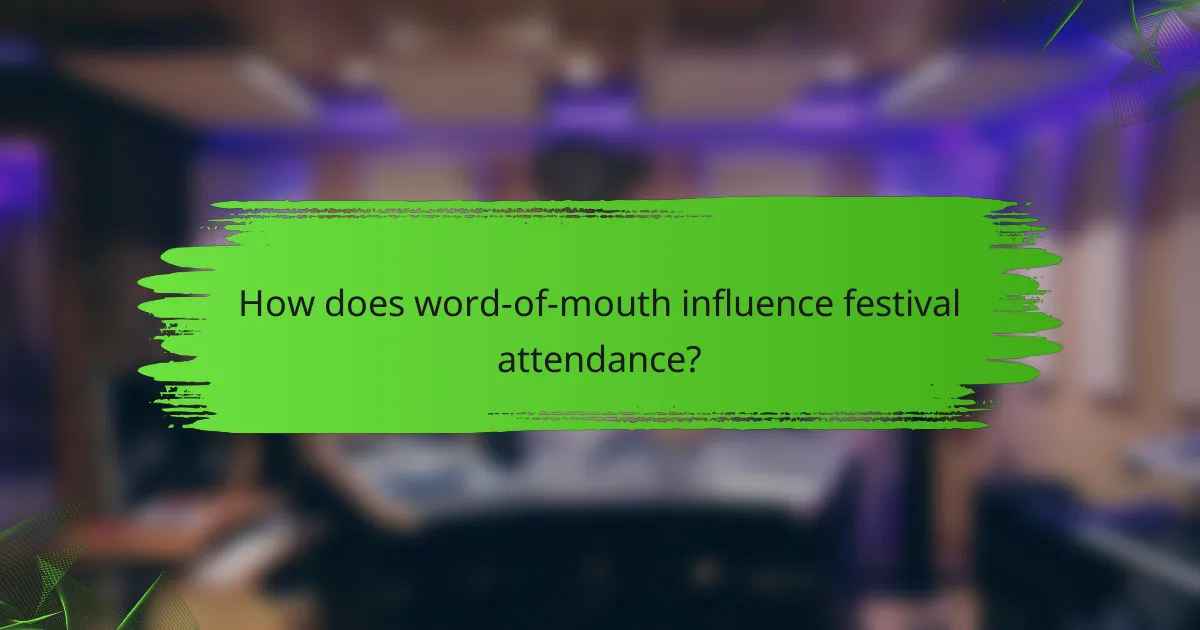
How does word-of-mouth influence festival attendance?
Word-of-mouth significantly impacts festival attendance by shaping perceptions and driving interest through personal connections. Recommendations from friends, family, or trusted sources create a sense of credibility that can motivate potential attendees to participate.
Personal recommendations
Personal recommendations are powerful because they come from trusted individuals who share their genuine experiences. When someone you know praises a festival, it can spark curiosity and encourage you to attend, especially if they highlight specific aspects like music quality or atmosphere.
To leverage personal recommendations, consider asking friends or family about their favorite festivals. Their insights can help you discover events that align with your interests and increase your likelihood of a positive experience.
Social media impact
Social media amplifies word-of-mouth influence by allowing users to share their festival experiences with a broader audience. Posts, photos, and reviews can create buzz and excitement, making festivals more appealing to potential attendees.
To maximize social media’s impact, follow festival pages and engage with content shared by attendees. Look for hashtags related to the event to find real-time feedback and insights from others, which can help you gauge the festival’s vibe and popularity.
Influencer endorsements
Influencer endorsements can sway festival attendance as they often have large followings and can reach diverse audiences. When a well-known figure shares their enthusiasm for a festival, it can lend credibility and attract new attendees who trust their opinion.
When considering influencer recommendations, evaluate their authenticity and relevance to your interests. Look for influencers who genuinely align with the festival’s theme or music genre, as their endorsements are likely to resonate more with their audience.
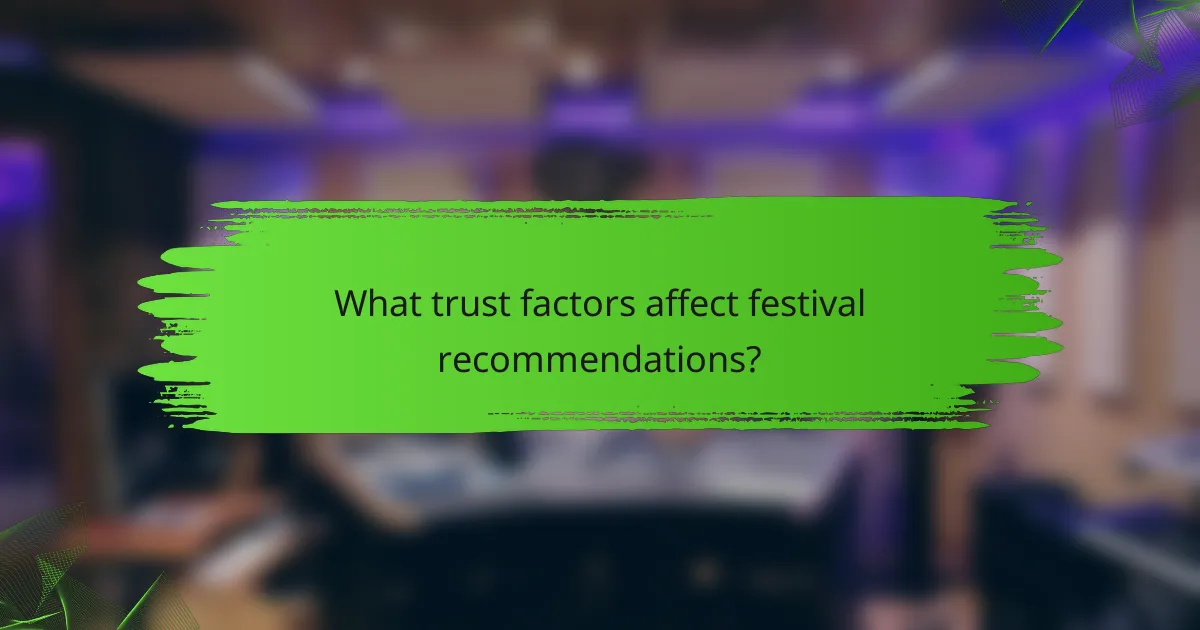
What trust factors affect festival recommendations?
Trust factors that influence festival recommendations include the reputation of artists, past attendee reviews, and the overall safety and organization of the event. These elements significantly shape perceptions and decisions when choosing which folk festivals to attend.
Reputation of artists
The reputation of artists performing at a festival plays a crucial role in attracting attendees. Well-known and respected artists can enhance the festival’s appeal and credibility, leading to higher attendance rates. When considering a festival, look for headliners with a strong following or positive reviews from previous performances.
Additionally, emerging artists with a growing fan base can also be a draw. Festivals that feature a mix of established and up-and-coming talent often create a diverse experience that appeals to various audiences.
Past attendee reviews
Reviews from past attendees are vital for gauging the quality of a festival. Positive feedback can indicate a well-organized event with enjoyable experiences, while negative reviews may highlight potential issues such as overcrowding or poor facilities. Check online platforms and social media for authentic attendee experiences.
Look for common themes in reviews, such as comments on the atmosphere, accessibility, and overall enjoyment. This can help you determine whether a festival aligns with your preferences and expectations.
Safety and organization
Safety and organization are critical factors that affect trust in festival recommendations. A well-organized festival prioritizes attendee safety through proper crowd management, security measures, and emergency protocols. Festivals that have a clear plan for handling emergencies tend to inspire more confidence among potential attendees.
Before attending, research the festival’s safety record and organizational reputation. Consider factors such as the availability of medical assistance, clear signage, and efficient entry and exit procedures. A festival that demonstrates a commitment to safety is more likely to provide a positive experience.
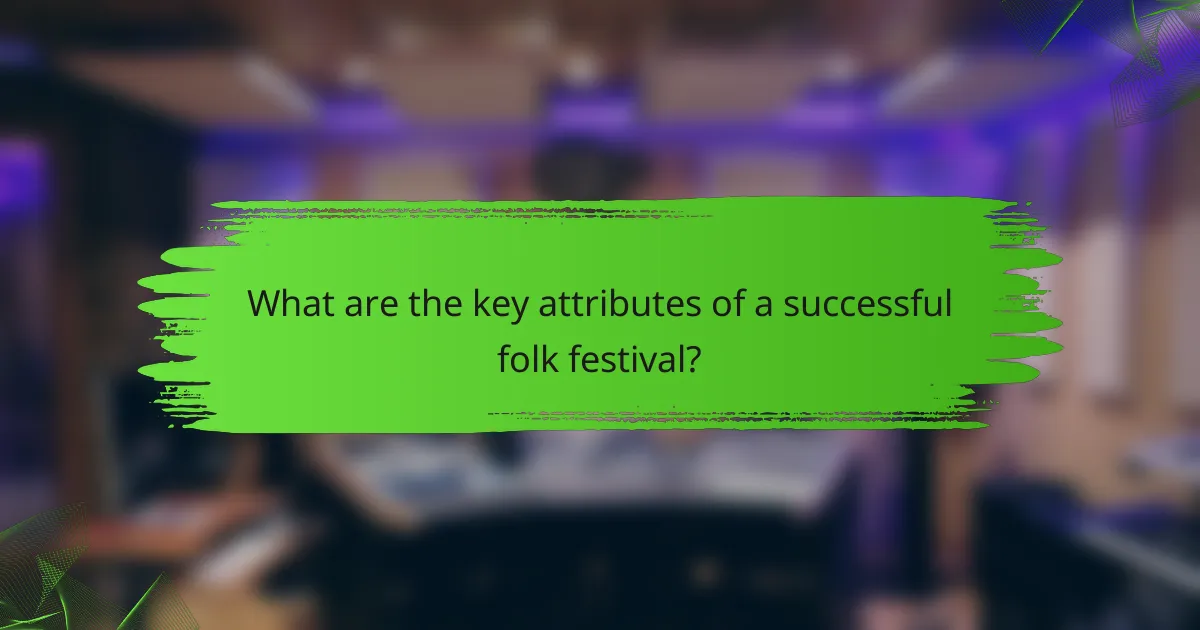
What are the key attributes of a successful folk festival?
A successful folk festival typically features a combination of diverse musical acts, strong community involvement, and convenient accessibility. These elements work together to create an engaging atmosphere that attracts attendees and fosters a sense of belonging.
Diverse lineup of artists
A diverse lineup of artists is essential for a folk festival to appeal to a broad audience. This includes not only various musical genres within folk but also artists from different cultural backgrounds. Festivals should aim to feature both well-known acts and emerging talent to keep the experience fresh and exciting.
Consider including local musicians alongside national or international performers to enhance community connection. A balanced mix can cater to different tastes and encourage attendees to explore new sounds.
Community engagement
Community engagement is crucial for building a loyal festival audience. Successful festivals often involve local organizations, schools, and businesses in the planning and execution stages. This collaboration can lead to a stronger sense of ownership and pride among residents.
Interactive activities such as workshops, storytelling sessions, and local craft markets can enhance engagement. These elements not only entertain but also educate attendees about the cultural significance of folk traditions.
Accessibility and location
Accessibility and location significantly impact attendance at a folk festival. Choosing a venue that is easy to reach by public transport and has ample parking options can increase participation. Additionally, ensuring the site is wheelchair accessible and offers facilities for families can make the event more inclusive.
Consider hosting the festival in a scenic outdoor location that complements the folk theme, such as parks or historical sites. This enhances the overall experience and encourages attendees to enjoy the natural surroundings while engaging with the music and community activities.
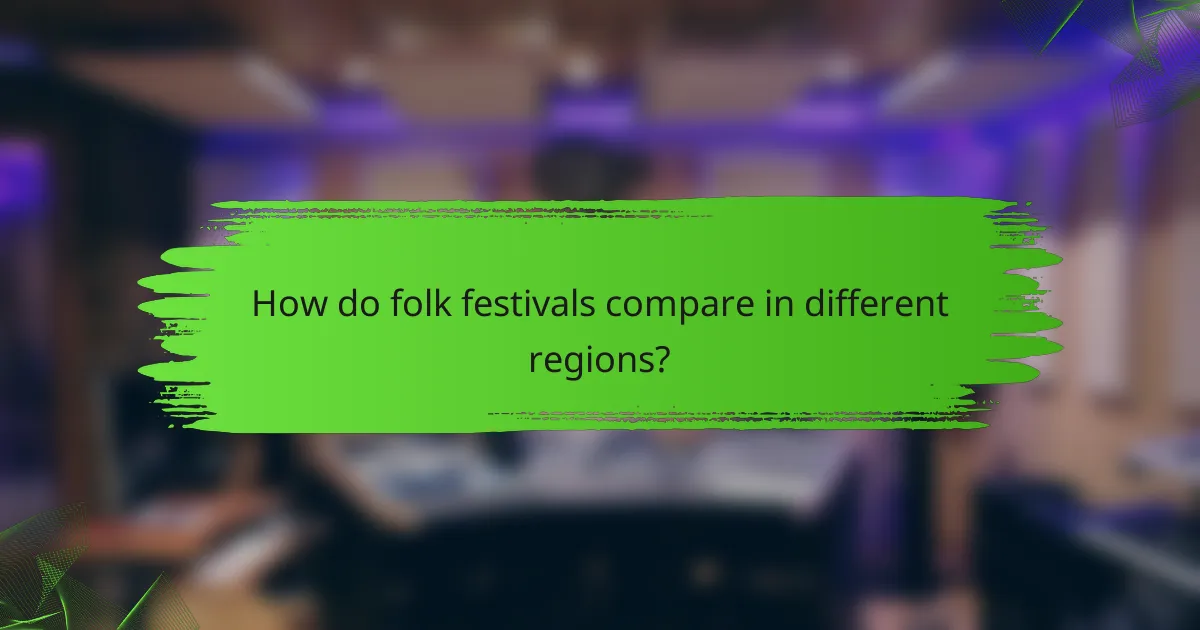
How do folk festivals compare in different regions?
Folk festivals vary significantly across regions, influenced by local culture, traditions, and community engagement. Understanding these differences can enhance your festival experience, whether you’re seeking vibrant performances or authentic local cuisine.
East Coast vs West Coast festivals
East Coast folk festivals often emphasize traditional music and storytelling, showcasing genres like bluegrass and Appalachian folk. Events such as the Newport Folk Festival in Rhode Island draw large crowds and feature a mix of established and emerging artists.
In contrast, West Coast festivals tend to blend folk with other genres, including rock and indie music. The Kerrville Folk Festival in Texas is known for its laid-back atmosphere and encourages participation from attendees, making it a unique experience.
Midwest folk festival highlights
The Midwest is home to several notable folk festivals, such as the Woody Guthrie Folk Festival in Oklahoma, which celebrates the legacy of the iconic musician. These festivals often feature local artisans and food vendors, creating a community-centric environment.
Another key event is the Milwaukee Folk Festival, which showcases a diverse range of folk music styles and cultural performances, reflecting the region’s rich heritage. Attendees can expect a mix of workshops and performances that engage all ages.
Southern folk traditions
Southern folk festivals are deeply rooted in the region’s history, often highlighting genres like blues, country, and gospel. The MerleFest in North Carolina is a prime example, celebrating traditional Appalachian music while also incorporating contemporary influences.
These festivals frequently include dance, storytelling, and local cuisine, providing a holistic cultural experience. The New Orleans Jazz & Heritage Festival also exemplifies Southern folk traditions, blending music with the vibrant local culture and culinary offerings.

What emerging trends are shaping folk festivals?
Emerging trends in folk festivals include a focus on sustainability, diversity in programming, and the integration of technology. These factors are reshaping how festivals operate and engage with audiences, reflecting broader societal changes and preferences.
Sustainability Practices
Many folk festivals are adopting sustainability practices to minimize their environmental impact. This includes using biodegradable materials, promoting recycling, and sourcing local food and crafts to reduce carbon footprints. Festivals like the Newport Folk Festival have implemented such measures, encouraging attendees to participate in eco-friendly initiatives.
Diversity in Programming
Diversity in programming is increasingly important at folk festivals, with organizers striving to include a wide range of cultural expressions and musical genres. This trend not only broadens the appeal of festivals but also fosters inclusivity. Festivals are now featuring artists from various backgrounds, ensuring that different voices and stories are represented on stage.
Integration of Technology
The integration of technology at folk festivals enhances the attendee experience and streamlines operations. Many festivals are utilizing mobile apps for scheduling, ticketing, and interactive maps. Additionally, live streaming performances has become common, allowing those unable to attend in person to engage with the festival remotely.
